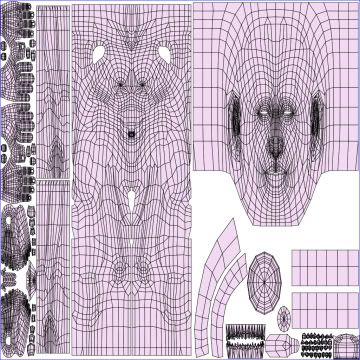Unfold.rb script: useful for UV-mapping?
-
Hi all,
I was wondering if it would be possible to use an adapted version of the unfold.rb to do some advanced texturing.
The unfold ruby basically unfolds an object to a 2D surface.
Now if we could project our texture (which we edit in Pshop ) to that unfolded 2D geometry, then fold it back to the original form with preservation of textures, we have ourselves an advanced UV-mapping tool ('uv-wrapping'), a feature only the dinosaur apps currently have.I would use it to texture free forms or any other form where the traditional projected texture method fails.
For really complex shapes, a ruby like that probably is way too memory 'expensive', but I can see it work for low to medium poly objects.
What do you guys think about this? Is this 'code-able'?
Regards,
Kwistenbiebel -
Excellent idea. I also would love to see this done. I have to say, I have used the unfold script. Obviously you can unfold and object but can you also refold it too?
Scott
-
Good point scott, i imagine it would have to be part of the script if you wanted to do it accurately.
-
something like this:
Texture creation in Pshop, apply textures on flat 2D and fold back to the original.
-
...good idea
 ...I am assured that it is possible
...I am assured that it is possible 

-
-
Howardhong,
Those look like imports from another app.
I doubt the texturing of the apple is done in SU. Or is it? -
The ZIP is supplied with the model in two formats: 3DS and what I think is for ArchiCAD.
-
Blender has the capability you are requesting, KB. Neatest part is where you can actually use painting tools on the unfolded map and then see them applied in the rendered viewport.
I haven't used it in a while, but now that I've been given a little project with a certain degree carte blanche I was planning on testing all kinds of integrations with SU, Blender, and more obscure programs.
-
Blender is such a pain.

I would love to be able to do things in SU as much as possible. -
@kwistenbiebel said:
Blender is such a pain.
Yes, it is.
And without a doubt, if you folks ever get your wish for a multi-processing, high-polygon-capable, NURBS-capable, IK-capable, super-dooper-Krytonite-resistant SU, it will also be a pain.
-
better not mention that kryptonite resistance thing too loudly lewis, might get people speculating again...
-
@Lewiswadsworth,
It's just a wish Lewis...just a wish.
I tried Blender, and yes it made me feel as if I miss some million brain cells to get control over it. (or a million spare hours to learn it).
Sketchup has a tradition of making otherwise difficult 3D tasks a whole lot easier.
So why wouldn't it be capable of making a complex thing like texturing easy? -
uv mapping coordination of .3ds model is reserved when imported to SU.
so i think it can be done by ruby script like other program used to do.
we all see the impossible things be done with script like ffd or subsmooth.
im expectintig somebody can make that kind of script.
-
This is an interesting thread, so in a nutshell what you are saying Chris is that say for instance the apple above, you first create the mesh then 'unwrap' it. You then export the 2d unwrapped image to an editor like Photoshop and you create the texture, the completed texture is then imported back into SU and applied to flattened mesh and then when folded the texture is perfectly mapped?
-
@solo said:
This is an interesting thread, so in a nutshell what you are saying Chris is that say for instance the apple above, you first create the mesh then 'unwrap' it. You then export the 2d unwrapped image to an editor like Photoshop and you create the texture, the completed texture is then imported back into SU and applied to flattened mesh and then when folded the texture is perfectly mapped?
Exactly, that's the idea.
-
Beibel
Mate yourn the money again! I thought about this the other day, even for simple models like context buildings or for examples like your idea for baked textures from podium. A simple form could be built and textured in SU - unwrapped - image edited to add details such as windows, doors etc and then rewapped to include the added details. Or when modelling with photomatch the unwrapped image could be edited easily to take out detail such as plants etc in the photo as needed to clean up the model.
Seems to me like a must for direct integration of SU for google with regards to google earth purposes!
I must say this really drives home the general need for better mapping functions in SU like spherical mapping!
-
@richard said:
Seems to me like a must for direct integration of SU for google with regards to google earth purposes!
Just mention Google earth some times more on the forum....maybe that wakes up the G-SU team

-
I Must say this idea is briliant, but instead of folding it back together why not try to make it like components? Unfold one, aplie texture and see the effect directly on another...
Would be awesome and very usefull!
-
Oh yes HFM,
Wonderful idea.
That way it would work like Whaat's subsmooth where you work on the proxy and the subsurface gets updated automatically.
Advertisement









